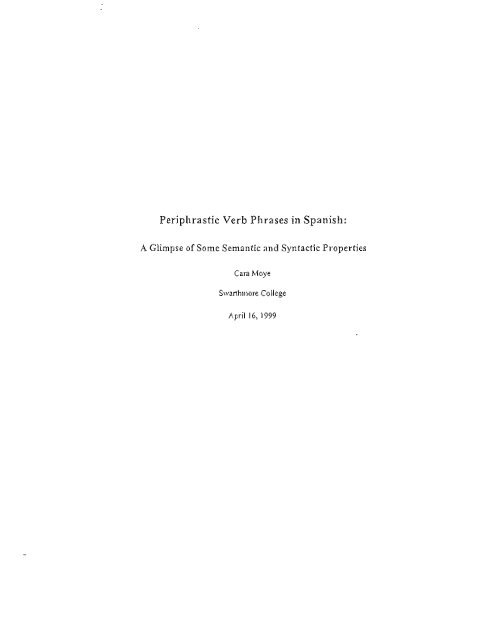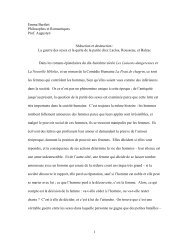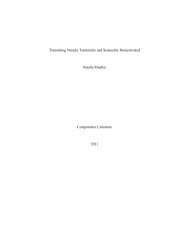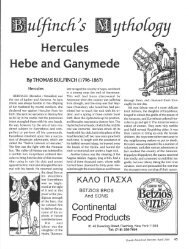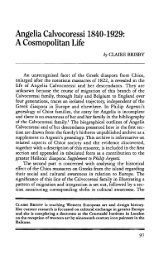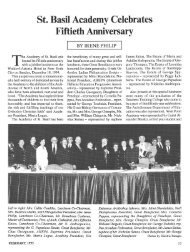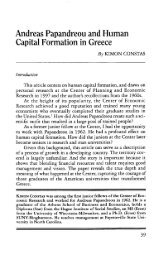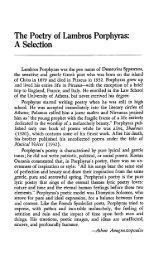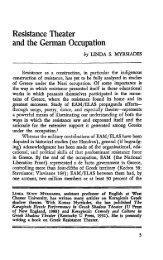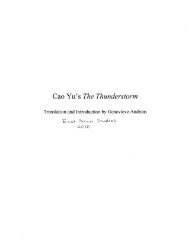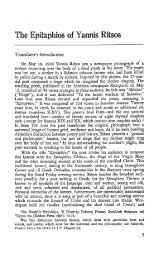Periphrastic Verb Phrases in Spanish:
Periphrastic Verb Phrases in Spanish:
Periphrastic Verb Phrases in Spanish:
You also want an ePaper? Increase the reach of your titles
YUMPU automatically turns print PDFs into web optimized ePapers that Google loves.
<strong>Periphrastic</strong> <strong>Verb</strong> <strong>Phrases</strong> <strong>in</strong> <strong>Spanish</strong>:<br />
A Glimpse of Some Semantic and Syntactic Properties<br />
Cara Moye<br />
Swarthmore College<br />
April 16, 1999
Title page<br />
Table of Contents<br />
1. Introduction<br />
II. Background Information<br />
Table of Contents<br />
A. Reasons for Us<strong>in</strong>g and Exam<strong>in</strong><strong>in</strong>g <strong>Periphrastic</strong>s<br />
B. When and Where do They Occur<br />
C. Dist<strong>in</strong>guish<strong>in</strong>g <strong>Periphrastic</strong> <strong>Phrases</strong><br />
D. Translat<strong>in</strong>g Periphrasties<br />
III. V IP Structures<br />
A. Lexical Entries and Sentence Structures<br />
B. ClWe Cllmb<strong>in</strong>g <strong>in</strong> VIP's<br />
C. Wh- Movement <strong>in</strong> VIP's<br />
D. Passive Movement <strong>in</strong> V lP's<br />
IV. V CP Structures<br />
A. Lexical Entries and Sentence Structures<br />
B. CHtic Climb<strong>in</strong>g <strong>in</strong> V CP's<br />
C. Wb- Movement <strong>in</strong> V CP's<br />
D. Passive Movement <strong>in</strong> V CP's<br />
V. Conclusion<br />
Bibliography<br />
1<br />
2<br />
3<br />
4<br />
4<br />
5<br />
10<br />
16<br />
24<br />
26<br />
30<br />
35<br />
37<br />
43<br />
44<br />
48<br />
52<br />
S6<br />
60<br />
61<br />
2
I. Introduction l<br />
In <strong>Spanish</strong>, there exists a verbal construction such that there are at least two verbs,<br />
and the first verb modifies the second verb. These structures vary slightly <strong>in</strong> their<br />
construction, from the V IP structure of anda vestido (goes around dressed? or anda<br />
mefi<strong>in</strong>dose (goes around mess<strong>in</strong>g) to the V CP construction of llega a verla (to actually<br />
see her. Nonetheless, these two types of structures act much alike <strong>in</strong> their semantic<br />
makeup. First, we will explore them <strong>in</strong> non-technical terms, see<strong>in</strong>g how l<strong>in</strong>guists<br />
explored them <strong>in</strong> the past, and look<strong>in</strong>g at their constructions us<strong>in</strong>g descriptive methods as<br />
opposed to generative grammar methods. In this section, we will explore what they are,<br />
what k<strong>in</strong>ds of verbs are used, and where and when they occur <strong>in</strong> the language. We will<br />
also note some problems that can occur <strong>in</strong> translation of these verb phrases, giv<strong>in</strong>g a<br />
speciflc example. After this non-technical background, the follow<strong>in</strong>g sections will focus<br />
on the syntax of these structures and how Govenunent and B<strong>in</strong>d<strong>in</strong>g Theory accounts for<br />
them. In these sections, we will look at the clausal V IP structure that is comprised of the<br />
<strong>Verb</strong> + Past Participle and the <strong>Verb</strong> + NDO constructions. Then we will look at more<br />
complicated data, which <strong>in</strong>cludes the V CP construction and problems that occur <strong>in</strong> GB<br />
Theory with these structures.<br />
I Acknowledgements: I would s<strong>in</strong>cerely like to thank Ted Fernald, Donna Jo Napoli,<br />
Kari Sw<strong>in</strong>gle, Charles O'Brien, Mar Campelos, Jesus Fernandez Alvarez, Just<strong>in</strong><br />
Aglialoro, Keith Early, Ellen Johnson, Carmen Bender, Cathy Bender, Arantxa Gil Irizar,<br />
Jill Ratzan, Brenda Baxter and Claudia Munoz for their suggestions, endless<br />
proof-read<strong>in</strong>g, support, and help. Any errors which doubtless rema<strong>in</strong> are, of course,<br />
mme.<br />
2 All translations are my own, unless otherwise specified.<br />
3
II. Background Information<br />
A. Reasons for Us<strong>in</strong>g and Exam<strong>in</strong><strong>in</strong>g <strong>Periphrastic</strong>s<br />
<strong>Spanish</strong> periphrastic phrases have become a very important topic <strong>in</strong> <strong>Spanish</strong><br />
l<strong>in</strong>guistics, due to their extensive use throughout the written and spoken language. The<br />
studies of this verbal phenomenon have been ongo<strong>in</strong>g <strong>in</strong> <strong>Spanish</strong> l<strong>in</strong>guistics s<strong>in</strong>ce the<br />
early 1900's. In earlier texts, such as Samuel Gili y Gaya's descriptive syntactic text<br />
(1943), we f<strong>in</strong>d the basis for many arguments today. The tendency <strong>in</strong> Spa<strong>in</strong> is to steer<br />
toward semantic descriptions and translation techniques, though the syntactic properties<br />
of theses PV's are also <strong>in</strong>terest<strong>in</strong>g. They properties differentiate them from regular verb<br />
phrases, as we will see.<br />
It has been said that <strong>Spanish</strong> speakers use the PV's so often because adverbs are<br />
not so commonly used <strong>in</strong> the language. This is because <strong>Spanish</strong> js such a<br />
rythm-conscious language, and adverbs can be extremely long. They are usually fanned<br />
by add<strong>in</strong>g -mente (two syllables) to the end of an adjective (which itself can sometimes<br />
be 3 or 4 syllables.) For <strong>in</strong>stance, an adjective like evidente (which means evident and<br />
has 4 syllables) with the addition of -mente, becomes evidentemente (6 syllables.) The<br />
length of adverbs can sound very strange, or as I was told by a native <strong>Spanish</strong> speaker<br />
from Spa<strong>in</strong>, it sounds "cargado," or stuffy. In addition, this can really break up rhythm,<br />
so speakers avoid us<strong>in</strong>g it whenever possible.<br />
One manner of gett<strong>in</strong>g this mean<strong>in</strong>g without us<strong>in</strong>g an adverb is by periphrastic<br />
verb phrases (pV's.) Perhaps because long adverbs are not avoided <strong>in</strong> languages such as<br />
4
English (and French) the tendency to have special verb phrases like these is much tess<br />
evident. Fewer PV's exists <strong>in</strong> these languages. English and French, for <strong>in</strong>stance, both<br />
share a common periphrastic phrase (<strong>in</strong> mean<strong>in</strong>g) with <strong>Spanish</strong>: to be go<strong>in</strong>g + <strong>in</strong>f<strong>in</strong>itive,<br />
aller + <strong>in</strong>f<strong>in</strong>itive, ir + a + <strong>in</strong>f<strong>in</strong>itive. The syntactic structures of the 3 languages are<br />
different, but <strong>in</strong> all of them the mean<strong>in</strong>g of some <strong>in</strong>tention <strong>in</strong> the future is added to the<br />
<strong>in</strong>f<strong>in</strong>itive verb. However, <strong>Spanish</strong> has over 60 of these structures, many more than<br />
English and French together.<br />
B. Where and When Do They Occur?<br />
The use of these verb phrases, as mentioned before, is really quite common <strong>in</strong><br />
Spa<strong>in</strong>. It ranges from very colloquial (andar -I- NDO or PP) to a very eloquent, poetic<br />
speech (haber de + <strong>in</strong>f<strong>in</strong>itive.) Social contexts do <strong>in</strong>fluence the choice of us<strong>in</strong>g a<br />
periphrastic phrase or not. Some periphrastic verbs modify the second verb <strong>in</strong> a way<br />
which has noth<strong>in</strong>g or very little to do with their non-periphrastic mean<strong>in</strong>g (while others<br />
take on a more figurative sense.) For <strong>in</strong>stance, <strong>in</strong> a phrase like 1, given below, andar<br />
really does not carry its mean<strong>in</strong>g to walk at all, but rather gives the impression that the<br />
speaker does not approve of the action, and that the doer of the action is do<strong>in</strong>g someth<strong>in</strong>g<br />
wrong. I have balded the periphrastic phrase to call attention to it:<br />
1. Este chiC
In this phrase, the boy does not walk. He isn't necessarily go<strong>in</strong>g anywhere. The<br />
speaker of the sentence has a pejorative concept of what the boy is do<strong>in</strong>g: mess<strong>in</strong>g with<br />
people. Andar is modify<strong>in</strong>g the mean<strong>in</strong>g of meterse. You could also say this phrase as <strong>in</strong><br />
sentence 2, without the verb andar, but it loses the displeasure on the part of the speaker:<br />
2. Este chico se mete con la gente.<br />
This boy (reflexive) messes with people.<br />
In fact, sentence 2, while not really eloquent due to the more colloquial usage of<br />
meterse (which can also mean to put or to place, and can itself be used periphrastically)<br />
would probably be more acceptable <strong>in</strong> a rigid social environment than sentence 1. The<br />
use of andar <strong>in</strong> periphrastic phrases is very colloquial. The change <strong>in</strong> mean<strong>in</strong>g is evident<br />
from the examples above. In sentence 1, we can certa<strong>in</strong>ly note that the mean<strong>in</strong>g of andar<br />
is not to walk, although <strong>in</strong> nonnal circumstances, and <strong>in</strong> all social environments, andar<br />
means to walk. Interest<strong>in</strong>gly enough, however, this verb is commonly used <strong>in</strong> many<br />
colloquial expressions. For <strong>in</strong>stance, a young Colombian friend of m<strong>in</strong>e once used the<br />
expreSSiOn:<br />
3. Esta n<strong>in</strong>a y yo, andamos muy bien.<br />
Literally: This girl and I, we walk very well.<br />
This girl and 1 get along really well.<br />
Andar <strong>in</strong> the you <strong>in</strong>fonna1 command fonn is often used as an exclamation that<br />
someth<strong>in</strong>g another speaker said or did is ridiculous, questionable, or not beJieved at all.<br />
A professor <strong>in</strong> Spa<strong>in</strong> once said to me, <strong>in</strong>credulously because I was carry<strong>in</strong>g a t<strong>in</strong>y<br />
bil<strong>in</strong>gual dictionary (which she deemed <strong>in</strong>adequate):<br />
6
4. iAy Dies mio! Anda! LY r6 te lIevas ese diccionario?<br />
Oh my lord! Get out! And you acrually carry around this dictionary?<br />
So andar does have a tendency to be used <strong>in</strong> colloquial situations, and it does<br />
have a tendency to stray from its more formal mean<strong>in</strong>g of to walk. There are many other<br />
verbs used <strong>in</strong> periphrastic phrases, of course. And the degree to which they stray from<br />
their non-periphrastic mean<strong>in</strong>g varies. For <strong>in</strong>stance, <strong>in</strong> a non-formal class sett<strong>in</strong>g, one can<br />
f<strong>in</strong>d periphrastic phrases such as no acabar de + <strong>in</strong>f<strong>in</strong>itive. I have <strong>in</strong>cluded no <strong>in</strong> this<br />
phrase because it adds frustration that does not occur when no is not present. In<br />
non-periphrastic phrases the verb acabar means to f<strong>in</strong>ish. In non-negative periphrastic<br />
phrases, acabar de modifies the second verb, add<strong>in</strong>g that the action of the second verb<br />
has just been completed. The negative of acabar de adds frustration that the action has<br />
not been completed entirely. A <strong>Spanish</strong> professor <strong>in</strong> class once addressed a student's<br />
shyness to repeat a question:<br />
5. No! jRepitelo! Es que no acabo de entender la primera parte.<br />
No! Repeat it! It's that I just didn't understand the first part!<br />
Here aga<strong>in</strong> the periphrastic phrase is <strong>in</strong> bold. The verb acabar <strong>in</strong> a<br />
non-periphrastic phrase can be used <strong>in</strong> any social context. <strong>Periphrastic</strong>ally it is possible<br />
that one would not f<strong>in</strong>d it <strong>in</strong> a very formal social sett<strong>in</strong>g. A non-periphrastic use of<br />
acabar is given <strong>in</strong> sentence 6:<br />
6. Se acab6 la Iluvia<br />
The ra<strong>in</strong> has just stopped.<br />
7
Acabar is a synonym for the verb term<strong>in</strong>ar, which also means 10 f<strong>in</strong>ish. However)<br />
a phrase like 7 can be generated without redundancy:<br />
7. Acabo de term<strong>in</strong>ar.<br />
I have just f<strong>in</strong>ished.<br />
This is because acabar no longer means to f<strong>in</strong>ish and is no longer <strong>in</strong>terchangeable<br />
with lerm<strong>in</strong>ar. Term<strong>in</strong>ar cannot be used <strong>in</strong> a periphrastic phrase, and the two verbs here<br />
cannot be reversed. Thus, you would never have a sentence like 8 generated:<br />
8 * Term<strong>in</strong>o de acabar<br />
I f<strong>in</strong>ish of to f<strong>in</strong>ish .<br />
Another common and rather colloquial periphrastic phrase is meterse a -I-<br />
<strong>in</strong>f<strong>in</strong>itive. As the second verb of a periphrastic verb phrase used before <strong>in</strong> example 1, we<br />
can see that this verb is very flexible <strong>in</strong> its colloquial mean<strong>in</strong>gs. The mean<strong>in</strong>g it adds to<br />
its second verb is one of <strong>in</strong>itiation of an action, but it also adds a rather pejorative aspect<br />
to the action. It gives an impression that the speaker judges that the doer of the action<br />
does not really know what he or she is do<strong>in</strong>g, or that the doer is not capable of do<strong>in</strong>g the<br />
action. While it can be a bit difficult to apply this translation <strong>in</strong> English, an example of<br />
this verb <strong>in</strong> a periphrastic phrase is given below <strong>in</strong> sentence 9. Because it is the speaker<br />
himself who is determ<strong>in</strong><strong>in</strong>g his own action <strong>in</strong> a pejorative manner, it is especially difficult<br />
to get the full mean<strong>in</strong>g of the periphrastic phrase when translat<strong>in</strong>g to English. A man <strong>in</strong> a<br />
tra<strong>in</strong> said to an acqua<strong>in</strong>tance <strong>in</strong> that tra<strong>in</strong>:<br />
9 Puedes jrte cuando quieras. No se: .. Es que me meto a hablar y ya veraS ...<br />
You can go whenever you like. I don't know. It's that T get wrapped up <strong>in</strong><br />
talk<strong>in</strong>g and ... you' 11 see.<br />
8
Meterse, <strong>in</strong> its formal usage, as mentioned earlier means to put or to place. Not<br />
only can it be used <strong>in</strong> fonnal contexts, but it is a more highly descriptive word than its<br />
synonymponerse, which also means to put or to place. Ponerse, additionally, can be<br />
used <strong>in</strong> periphrastic verb phrases. Another synonym, which is deemed even more<br />
eloquent and more fonnal than either of these two is the verb coiocar, and it cannot be<br />
used as a periphrastic verb. This will become more important later when we look at the<br />
semantic tendencies of peri phrastic verbs.<br />
All of the former examples of periphrastic phrases have been <strong>in</strong> an at least<br />
somewhat colloquial envirorunent. However, as mentioned before, some of them do<br />
occur frequently <strong>in</strong> very formal speech too. In a political and economic book, As{<br />
CambiarcfEspana, the writer addresses his audience <strong>in</strong> a very fonnal sett<strong>in</strong>g, and quotes<br />
several politicians address<strong>in</strong>g their pubJic. One politician (Pierre \flimlun) was quoted as<br />
saymg:<br />
]0 .. .1a unificacion de Europa es una idea justa y por ello acabad triunfando .<br />
... the unification of Europe is ajust idea and because of that, it will end up triumphant<br />
Aga<strong>in</strong> we already know that the verb acabar means fo f<strong>in</strong>ish, and that it is used to<br />
mean fo have just when used with de and an <strong>in</strong>f<strong>in</strong>itive. In the phrase above it is used with<br />
the -NDO (the progressive) form of the verb triumph, and is not colloquial at all. Also, it<br />
has only undergone a slight alteration of mean<strong>in</strong>g, s<strong>in</strong>ce it still carries a mean<strong>in</strong>g of to<br />
f<strong>in</strong>ish or end <strong>in</strong> both periphrastic phrases.<br />
9
Thus, we can draw from the examples above that the PV's do occur <strong>in</strong> all levels of<br />
the language, but that certa<strong>in</strong> periphrastic phrases are usable <strong>in</strong> colloquial contexts only.<br />
We have also seen a glimpse of how verbs that are used often <strong>in</strong> colloquial contexts are<br />
often used <strong>in</strong> expressions, and are flexible verbs <strong>in</strong> that they can carry a variety of<br />
mean<strong>in</strong>gs depend<strong>in</strong>g on the context, can be used periphrastically.<br />
C. Dist<strong>in</strong>guish<strong>in</strong>g <strong>Periphrastic</strong> <strong>Phrases</strong><br />
In this section, we will mostly look at the different arguments among l<strong>in</strong>guists<br />
today about what does and does not make up a periphrastic verb phrase. In addition, we<br />
will see some <strong>in</strong>terest<strong>in</strong>g occurrences and uses of periphrastic phrases. Accord<strong>in</strong>g to<br />
many l<strong>in</strong>guistics, one of the requisites that a verb phrase must fulfill <strong>in</strong> order to be called<br />
periphrastic is the loss of the orig<strong>in</strong>al mean<strong>in</strong>g of the conjugated verb. That is to say, the<br />
conjugated verb modifies the second verb, and not with the mean<strong>in</strong>g it carries when used<br />
alone. One standard way of say<strong>in</strong>g this was to say that the first verb acts as an auxiliary<br />
verb. Accord<strong>in</strong>g to Samuel GilL y Gaya (1943, p. 95), "para dist<strong>in</strong>guir si un verbo esta'<br />
empleado como auxiliar basta fijarse en si ha perdido su significado propio." (In order to<br />
determ<strong>in</strong>e if a verb is employed as an auxiliary, all that is needed is to look at whether or<br />
not it has lost its own mean<strong>in</strong>g.) This is still one method used to identify peliphrastic<br />
phrases.<br />
The real problem that occurs with this type of explanation is that there are verb<br />
phrases <strong>in</strong> which the first verb does not really lose its orig<strong>in</strong>al mean<strong>in</strong>g, but rather<br />
modifies the second verb with the mean<strong>in</strong>g that it carries when used alone. If the above<br />
10
expressions may be slightly less common. And f<strong>in</strong>ally <strong>in</strong> the third tier, we f<strong>in</strong>d verbs that<br />
do not have a variety of mean<strong>in</strong>gs, and are not flexible to the extent that they can be used<br />
. .<br />
In expressIOns.<br />
To put these observations to use, let us now look at some verbs that cannot occur<br />
<strong>in</strong> periphrastic phrases. It is <strong>in</strong>terest<strong>in</strong>g to note, look<strong>in</strong>g at the chart, the absence of high<br />
<strong>in</strong>fonnation verbs, and of verbs used <strong>in</strong> the most elegant of speech registers. What does<br />
this mean? We can look, for <strong>in</strong>stance, to the three verbs poner, meter, and coloear. All<br />
three of these verbs can mean 10 put or fO place. PoneI' is used <strong>in</strong> everyday language, and<br />
also carries a variety of other mean<strong>in</strong>gs. Its usage can be very colloquial, and it is not<br />
considered at all eloquent. Meter also has a variety of mean<strong>in</strong>gs, but when used formally<br />
as to put or to place, it is a bit more eloquent thanponer. Coloear is very specific,<br />
mean<strong>in</strong>g only 10 put or 10 place (someth<strong>in</strong>g somewhere.) It is used <strong>in</strong> a highly eloquent<br />
speech, and is not used as a periphrastic verb.<br />
Another <strong>in</strong>stance that is <strong>in</strong>terest<strong>in</strong>g is the difference between andar and cam<strong>in</strong>ar.<br />
Both mean to walk. Cam<strong>in</strong>ar is not used <strong>in</strong> expressions, and it is not used <strong>in</strong> slang. It<br />
cannot be found <strong>in</strong> a periphrastic phrase. As we have already seen, andar is used <strong>in</strong><br />
expressions, and <strong>in</strong> slang. And of course, it is used <strong>in</strong> <strong>Periphrastic</strong> <strong>Verb</strong> <strong>Phrases</strong>.<br />
We can see now that periphrastic verbs tend to be those with multiple mean<strong>in</strong>gs <strong>in</strong><br />
non-periphrastic phrases, or verbs that can be used <strong>in</strong> expressions, or <strong>in</strong> less rigid social<br />
environments. It is especially <strong>in</strong>terest<strong>in</strong>g to note the modal verb deber and its<br />
periphrastic use. In most languages, the episternic and deontic use of this modal are the<br />
same syntactic structures, but elegant <strong>Spanish</strong> draws a l<strong>in</strong>e between the two. The<br />
14
epistemic use is a periphrastic phrase, whereas the deontic use is the modal alone. For<br />
<strong>in</strong>stance, <strong>in</strong> example 11 below, the periphrastic phrase gives a different mean<strong>in</strong>g than the<br />
modal alone would give, follow the most elegant <strong>Spanish</strong> register:<br />
11. Sacas muy buenas notas,iy no estudias! Debes de ser muy <strong>in</strong>teligente.<br />
You get good grades and you don't study. You must be very <strong>in</strong>telligent.<br />
The verb deber as a modal, non-periphrastically, would be used as <strong>in</strong> an <strong>in</strong>stance like<br />
sentence 12:<br />
12. Debes estudiar mucho; queremos que saques muy buenas notas.<br />
You must study alo!; we want you to get good grades.<br />
The difference between these two forms of deber is rather important, and it might<br />
be an error to say that this verb realJy carries the same mean<strong>in</strong>g periphrastically that it<br />
carries orig<strong>in</strong>ally. I have put it <strong>in</strong> tier 3 nonetheless because these two fonns have<br />
become practically <strong>in</strong>terchangeable for a phrase like II, the epistemic use, <strong>in</strong> Spa<strong>in</strong> today.<br />
While 13 is not considered correct, many people see no difference between say<strong>in</strong>g 11 and<br />
13:<br />
13. Sacas rnuy buenas notas,' y j no estudias! Debes ser muy <strong>in</strong>teligente.<br />
You get good grades and you don't study. You must be very <strong>in</strong>teligent.<br />
However, nobody would make the mistake of confus<strong>in</strong>g the periphrastic phrase<br />
with the modal <strong>in</strong> 12. The deontic use of the modaJ alone is not <strong>in</strong>terchangeable with the<br />
periphrastic phrase, so one would probably never encounter a sentence like 14:<br />
14 . *Debes de estl.ldiar mucho; queremos que saques muy buenas notas.<br />
Try<strong>in</strong>g to say: You must sll.ldy a lot. We want you to get good grades.<br />
15
The difference between the periphrastic phrase and the modal verb is not marked<br />
<strong>in</strong> English, as we see from the translations above. The periphrastic phrase does carry a<br />
different mean<strong>in</strong>g though. To wrap up this section, we can note that while l<strong>in</strong>guists do<br />
not agree on what detenn<strong>in</strong>es a periphrastic verb phrase, all possible periphrastic phrases<br />
do share one th<strong>in</strong>g <strong>in</strong> common: they all are of verbs that have multiple mean<strong>in</strong>gs, are<br />
colloquial, or are not high <strong>in</strong>formation verbs. This could be enough of a semantic tie to<br />
ignore whether the verb completely loses its non-periphrastic mean<strong>in</strong>g or not.<br />
D. Translat<strong>in</strong>g <strong>Periphrastic</strong>s<br />
Translat<strong>in</strong>g periphrastic verb phrases can be especially difficult. The real<br />
question, for at least some periphrastics, is whether you can translate them us<strong>in</strong>g the same<br />
method from context to context, or whether each context calls for an <strong>in</strong>dividual treatment<br />
of each periphrastic phrase. In other words, do they add the same basic mean<strong>in</strong>g to the<br />
verb they modify) no matter what the context? Or does the alteration of mean<strong>in</strong>g also<br />
depend on the context? To answer these questions, we will focus on one periphrastic<br />
phrase that does not have an equal periphrastic counterpart <strong>in</strong> English. The periphrastic<br />
verb wi1l be used <strong>in</strong> several different contexts, with several different verbs. OUf<br />
periphrastic phrase will be llegar a + <strong>in</strong>f<strong>in</strong>itive.<br />
Accord<strong>in</strong>g to Jesus Fernandez, !legar a can <strong>in</strong>dicate conseguir (to achieve), or a<br />
nuance of "ir hasta el extrema" (to ga to extremes.) In addition, he suggests that it<br />
sometimes adds a feel<strong>in</strong>g of " por f<strong>in</strong>.''' (F<strong>in</strong>ally!!) With no, it expresses a<br />
disappo<strong>in</strong>tment, "s<strong>in</strong> realizacion" (without realization.) From Fernandez's explanation<br />
16
of what !legar a can add to an <strong>in</strong>f<strong>in</strong>itive, we might already suspect that this PV cannot be<br />
translated the same way all of the time. In examples 15-17, we have 3 phrases conta<strong>in</strong><strong>in</strong>g<br />
the periphrastic phrase lIegar a. The translation underneath each one is not complete.<br />
The would-be translation of the PV llegar a has been Jeft blank, to look at possible<br />
translations of the periphrastic phrase.<br />
In these three examples 15-17, there are many periphrastic phrases. Focus<strong>in</strong>g <strong>in</strong><br />
on !legar a, there are four occurrences. We will go through each occurrence now, and try<br />
to figure out just what the periphrastic verb is add<strong>in</strong>g to the ma<strong>in</strong> verb.<br />
15 El canciller aleman, Helmet Kohl, afmno que "el combate fue extraord<strong>in</strong>ariamente duro" y<br />
que lJeg6a dudar de la posibilidad del acuerdo."<br />
El Euro nace con Dolor<br />
Xavier Vidal-Folch<br />
El Pais<br />
The German chancellor, Helmet Kohl, affirmed that "the combat was extraord<strong>in</strong>arily difficult"<br />
and thal ______ the possibility of agreement."<br />
In example 15, lleg6a dudar is our PV. Dudar means to doubt. We know that<br />
this PV can carry a mean<strong>in</strong>g of realization; here it seems to carry a measure of start<strong>in</strong>g or<br />
beg<strong>in</strong>n<strong>in</strong>g (to doubt.) The actualization of doubt<strong>in</strong>g is what is important; the fact that he<br />
doubted at all is stressed by Ilegoa. To capture this, we could maybe say<br />
15.a He actually doubted the possibility of an agreement.<br />
Because !legar a also <strong>in</strong>dicates, <strong>in</strong> this <strong>in</strong>stance, some sort of beg<strong>in</strong>n<strong>in</strong>g of doubt<strong>in</strong>g, and<br />
actually may not express this, a better translation may be:<br />
IS.b The Gennan chancellor ... and that he actually began to doubt the<br />
possibility of the agreement.<br />
17
Actually should be ma<strong>in</strong>ta<strong>in</strong>ed <strong>in</strong> this translation <strong>in</strong> order to keep the sense of<br />
stress<strong>in</strong>g that he shouldn't have had to doubt the possibility, or the fact that he had to at<br />
all is important. The actualization of doubt<strong>in</strong>g is stressed. 3 Of course) it's really difficult<br />
to say what the best translation is, but 15.b seems to capture it pretty well. Let's look at<br />
some other examples:<br />
16 ... nos caJlabamos a escuchar como embobados. pero cuando mvimes mas arran que,<br />
por el v<strong>in</strong>o y Ja conversacion, nos liamos a cantar en rueda y, aunque nuestras voces<br />
no eran demasiado templadas, como lIegaron a decirsc cosas divertidas, todo se nos<br />
era perdonado ...<br />
La Familia de Pascual Duarte<br />
Camilo Jose Cela<br />
... we quieted down like idiots to listen, but when we got started up by the w<strong>in</strong>e<br />
and conversation we gathered <strong>in</strong> a circle and began s<strong>in</strong>g<strong>in</strong>g without direction,<br />
and even though our voices weren't really <strong>in</strong> tune, s<strong>in</strong>ce they ____ _<br />
funny th<strong>in</strong>gs, we were forgiven all.<br />
In example 16, our PV is llegaron a decirse. Decir means to say, and the<br />
reflexive here <strong>in</strong>dicates that the say<strong>in</strong>g occurs among them. It acts as a sort of passive<br />
construction and puts cosas divertidas (funny th<strong>in</strong>gs) <strong>in</strong> the agent role. Thus, before<br />
translat<strong>in</strong>g llegar a, we should pay attention to the structure itself, and change the English<br />
structure to:<br />
16 a .. . s<strong>in</strong>ce funny th<strong>in</strong>gs were said .. .<br />
Now we will focus <strong>in</strong> on what llegar adds to this translation. The stress is on how<br />
the th<strong>in</strong>gs were funny. Aga<strong>in</strong>, as <strong>in</strong> Example 15, we could probably use actually:<br />
3 Another <strong>in</strong>terest<strong>in</strong>g side 110te is the choice of the adverb extraord<strong>in</strong>ariamente by the German (non-native)<br />
<strong>Spanish</strong> Speaker. The word has 9 syllables, and is quite a standout <strong>in</strong> the phrase. After read<strong>in</strong>g the article<br />
through, it is quite a standout <strong>in</strong> the writ<strong>in</strong>g style.<br />
18
16.b ... s<strong>in</strong>ce funny th<strong>in</strong>gs were actually said ...<br />
This translation may be a bit awkward and hard to <strong>in</strong>terpret. It does not really fit<br />
<strong>in</strong> well with the context of the phrase. To f<strong>in</strong>d a way to say this <strong>in</strong> English is very<br />
difficult. One native English speaker who has lived <strong>in</strong> Spa<strong>in</strong> for over 10 years and speaks<br />
the language very well suggested that the phrase just be translated as <strong>in</strong> 16.c:<br />
16.c ... and s<strong>in</strong>ce funny th<strong>in</strong>gs were said ...<br />
There are certa<strong>in</strong>ly reasons to reject a translation like this one, even if f<strong>in</strong>d<strong>in</strong>g<br />
another is extremely difficult. Translation 16.c is ofthe phrase se dijeron cos as<br />
divertidas and not of llegaron a decirse cosas diverlidas. In the end I would refer to 16.b<br />
as the best translation. More than anyth<strong>in</strong>g, this shows just how difficult translat<strong>in</strong>g PV's<br />
can be. Another example we can look at which conta<strong>in</strong>s the PV llegar a two times,<br />
shows even more problems wjth translat<strong>in</strong>g this PV:<br />
17 Mucha me diQ que pensar, en muchas veces, y aun ahara mismo si he de decir<br />
la verdad, el motivo de que a mi madre Hegase a perderle el respeto, primero, y el car<strong>in</strong>o<br />
y las fonnas al andar de los anos, mucha me dio que pensar. porque queria hacer<br />
un claro en la memoria que me dejase ver hacia que tiempo dejo de ser una madre<br />
en mi corazon y hacia que tiempo lIeg6despues 8 convertirseme en un enemigo.<br />
La Familia de Pascual Duarte<br />
Camilo Jose Cela<br />
[t gave me a lot to th<strong>in</strong>k about, times over. and even now if I must tell the truth,<br />
the reason why I _ ____ respect and the car<strong>in</strong>g ways for my mother over<br />
the years, it gave me alot to th<strong>in</strong>k about. because I wanted to clear my memory so<br />
that r could see when she quit be<strong>in</strong>g a mother <strong>in</strong> my heart and when she<br />
_______ <strong>in</strong> an enemy.<br />
In example 17 we have llegar a two times: llegase a perderle (perderle means to<br />
lose plus the object, here be<strong>in</strong>g mi madre or my mother,) and lleg6 ... a convertirseme<br />
19
(convertirse means fo convert with its reflexive, and the me refers to the speaker.) In the<br />
first <strong>in</strong>stance, Pascual Duarte is say<strong>in</strong>g that he lost respect for his mother. Before add<strong>in</strong>g<br />
the periphrastic modification, a usual translation might be:<br />
17.a .. .the reason why I first lost respect for my mother, and over the years the car<strong>in</strong>g ways .. .<br />
The modification of !legar a here is to stress los<strong>in</strong>g. I'm not sure that actually<br />
quite captures the mean<strong>in</strong>g of the phrase, because it isn't stressed that its odd that he lost<br />
respect at all, but rather that somehow he lost it. For this reason, even though actually<br />
could probably be used here, I would have a preference for a translation Jike 17. b:<br />
17.b ... the reason why [ ftrst somehow lost respect for my mother, and over the<br />
years the car<strong>in</strong>g ways ...<br />
In translation 15.a, we <strong>in</strong>cluded actually began <strong>in</strong> place of the periphrastic phrase.<br />
Here aga<strong>in</strong> there is some h<strong>in</strong>t of focus <strong>in</strong> when he lost respect, but this time ir comes from<br />
the context, and the word first. The beg<strong>in</strong>n<strong>in</strong>g <strong>in</strong> began to doubt also comes more from<br />
the context than the periphrastic verb itself, probably. It is difficult to separate the two.<br />
Perhaps it is not necessary.<br />
In the second llegar PV, llego (despues) a convertirseme, we have the reflexive se<br />
(referr<strong>in</strong>g to the one who converts), and the clitic me, referr<strong>in</strong>g to Pascual, the speaker.<br />
Before the periphrastic modification, the translation I would propose is:<br />
17.c .,. and when she turned me <strong>in</strong>to an enemy ...<br />
20
We could say converted me <strong>in</strong>to an enemy, but this would probably not be an<br />
elegant translation. Convert doesn't fit the tone of the text; it's too stuffy. As for the<br />
addition of !legar a here, aga<strong>in</strong> it stresses the actualization of her mak<strong>in</strong>g him an enemy,<br />
and, aga<strong>in</strong> actually could be used <strong>in</strong> the translation.<br />
17.d .. . and when she actually turned me <strong>in</strong>to an enemy.<br />
After look<strong>in</strong>g rather quickly at these examples, one may want to say that llegar a<br />
simply adds actually to the sense of the verb. However, by look<strong>in</strong>g closer at the texts we<br />
have seen that it is not that simple at all. It is really difficult to say whether or not each<br />
translation with this verb really needs to be treated <strong>in</strong>dividually. When llegar a does not<br />
follow no, or is not followed by ser, however, actually may be a decent translation.<br />
There will always be exceptions though. Example B was rather difficult to translate.<br />
Perhaps actually is not the best word choice. And actually certa<strong>in</strong>ly does not work with<br />
ser. Llegar a ser is always translated as fo become, as seen here <strong>in</strong> example 18:<br />
18 EI Ileg6a ser presidente<br />
He became president<br />
In addition, we can see with examples 19-21 below that no llegar a is different.<br />
Actually does not translate well <strong>in</strong> all of these exampJes:<br />
19 Queda ver la pelicula, perc no lIegu{ a verla.<br />
I wanted to see the movie, but I ___ _<br />
21
would happen if we took it out of translation 19.b? Would the translation still be good?<br />
We can see this result <strong>in</strong> 19.d:<br />
19.d I wanted to see the movie, but I just didn '( see it.<br />
19.d, like 19.c, does not express the disappo<strong>in</strong>tment or frustration at not see<strong>in</strong>g the<br />
movie. Thus, the comb<strong>in</strong>ationjust + no! + get to (19.b), is probably the best translation<br />
for 19.<br />
Given another context with no lIegar a, would the same translation fit? Example<br />
20 is from another passage <strong>in</strong> La Familia de Pascual Duarte:<br />
20 Yo andaba preocupado y como pensativo, como temoroso del paso que iba a dar --<br />
casarse es una cosa muy seria, ;que caramba! -- y momentos de Oaqueza y desfallecimiento tuve,<br />
en los que Ie aseguro que no me falto nada para volverme atras y mandarlo todo a tamar vientos,<br />
cosa que si no lIegu{ a hacer fue por pensar que como la campanada iba a ser muy gorda y, en<br />
realidad, no me habia de quitar mas miedo ...<br />
La Familia de Pascual Duarte, 82 .<br />
Camilo Jose CeJa<br />
I went around worried, and somehow pensive, apprehensive about the step T was about to<br />
take -- to get married is a very serious th<strong>in</strong>g, geez! -- and r had moments of weakness and<br />
falter<strong>in</strong>g, moments <strong>in</strong> which I assure you it wouldn't have taken much to make me tum back and<br />
tell them all to get lost, which ifl , it was because I was th<strong>in</strong>k<strong>in</strong>g about how the bells<br />
were go<strong>in</strong>g to r<strong>in</strong>g out, and really, that took away enough of the fear.<br />
Si nunca llegut'a hacer is a very <strong>in</strong>terest<strong>in</strong>g phrase to translate. Us<strong>in</strong>g our<br />
previous comb<strong>in</strong>ation, we would get a translation like 20.a:<br />
23
20.a someth<strong>in</strong>g that if I just never got to do,<br />
This sounds like he really wanted to do it. From the context we can draw that that<br />
is not necessarily the case. In fact, for the flow of the context, our earlier translation of<br />
actually may be the best:<br />
20.b someth<strong>in</strong>g that ifl never actually did it...<br />
This translation expresses that he thought a lot about do<strong>in</strong>g it, but he never<br />
actually did. The real sense of the passage is captured by this translation through the<br />
word actually. Because for as much as he thought about it, he did not actually do it. And<br />
that's what the phrase captures. 20b captures that well. Thus, no llegaf a does not<br />
always <strong>in</strong>dicate a frustration for not hav<strong>in</strong>g gotten to do someth<strong>in</strong>g. It can also <strong>in</strong>dicate<br />
the counterpart of llegar a, by simply mean<strong>in</strong>g not actualized.<br />
For almost any context, this periphrastic phrase has to be treated <strong>in</strong>dividually <strong>in</strong><br />
translation. There seems to be no lone method of translat<strong>in</strong>g it. This occurs with many of<br />
these <strong>Spanish</strong> periphrastics, and is one of the ma<strong>in</strong> reasons so many l<strong>in</strong>guists are study<strong>in</strong>g<br />
just what is beneath each phrase.<br />
III. V IP Structu res<br />
As we mentioned before <strong>in</strong> earlier sections, PV's <strong>in</strong>clude two basic types of<br />
structures. In this section we will look at the V IP periphrastic structures and their<br />
24
syntactic characteristics, <strong>in</strong>clud<strong>in</strong>g the types of movement they allow. The V IP<br />
structures are those that have a periphrastic verb and either the past participle or the<br />
-NDO form of another verb. Some possible V IP periphrastic phrases are given below <strong>in</strong><br />
sentences 21-23:<br />
21 Este chico anda metilndose con la gente.<br />
This boy goes around mess<strong>in</strong>g with people.<br />
22 Yo andaba preocupado.<br />
r went around worried.<br />
23 a. Vaya ir yfndome<br />
b. Me lIoy a ir yendo.<br />
I'm go<strong>in</strong>g to get go<strong>in</strong>g.<br />
21 should look familiar, as we saw it earlier. In 21 we have the V (anda) IP<br />
(metiendose con la genIe) structure where the IP verb is the progressive (or -NDO) form.<br />
In addition, we see the reflexive se adjo<strong>in</strong>ed to the end -of the progressive. Later we will<br />
look at movements of this se, and of c1itics that can adjo<strong>in</strong> to the progressive.<br />
22 gives us an example of a V IP structure where the second verb is the past<br />
participle. The past participle <strong>in</strong> 22 agrees <strong>in</strong> number and gender with its theme yo. Tills<br />
phrase may also look familiar, as it was taken from an earlier example which was chosen<br />
from a passage <strong>in</strong> La Familia de Pascual Duarte.<br />
23 is an especially <strong>in</strong>terest<strong>in</strong>g structure. First we have the V CP structure of voy a<br />
ir, and <strong>in</strong> addition we have the V IP structure of ir yendo. The reflexive me can be either<br />
attached to the progressive (as <strong>in</strong> B) or raised up <strong>in</strong> front of the first verb phrase ofthe<br />
structure (as <strong>in</strong> A.) This first verb construction (voy a ir) is the CP structure we will later<br />
25
explore. For now, lets look at the deep structure and surface structure of the V IP<br />
phrases, with their lexical entries:<br />
A. Lexical Entries and Sentence Structures<br />
First we'll look at the lexical entries of our verbs. In sentence 21, we have andar<br />
and melerse. In giv<strong>in</strong>g the entries for periphrastic verbs, we can either give lexical entries<br />
for verbs when used periphrastically and non-periphrastically, or just when used<br />
periphrastically. All that really <strong>in</strong>terests us are the periphrastic uses when the verbs are<br />
periphrastic. Thus, when periphrastic, we will only deal with them. This means we'll<br />
ignore uses such as:<br />
24. Este chico anda por la calle.<br />
This boy walks the road.<br />
Purposefully overlook<strong>in</strong>g uses like these, andar takes only an IP. The verb of this<br />
IP can be <strong>in</strong> either the progressive or the past participle fonn. No other fonn works.<br />
Thus, the subcategorization frame for andar would be as given <strong>in</strong> 25:<br />
25. Andar, V [_ IP [+ f<strong>in</strong>J]<br />
The IP phrase it takes must be f<strong>in</strong>ite. As for melerse, <strong>in</strong> this <strong>in</strong>stance, it takes a PP<br />
sister where [con] is specified. So it's subcategorization frame is shown <strong>in</strong> 26:<br />
26. meterse, V [_ PP [con]]<br />
Melerse can also take a CP sister as a periphrastic phrase (meterse a), but the<br />
periphrastic meterse is not the one used <strong>in</strong> sentence 21, nor subcategorized for <strong>in</strong> 26.<br />
26
assign an external theta role. It does, however assign an <strong>in</strong>ternal theta role to its sister IP<br />
(or CP) clause. This means the lexical entry of the periphrastic andar is as shown <strong>in</strong> 28:<br />
28. an dar, V [_ IP[+f<strong>in</strong>) ]<br />
<br />
Andar assigns one theta role, and that is to its IP phrase. Sentences 21 and 22<br />
should have the same basic structure, even though their IP phrases may differ. Because<br />
sentence 22 is very <strong>in</strong>terest<strong>in</strong>g <strong>in</strong> that the past participle must concur <strong>in</strong> number and<br />
gender with the subject, and because the deep structure of these two constructions as<br />
periphrastic verb phrases will be similar, we will exam<strong>in</strong>e the likely deep structure and<br />
surface structure of 22. To do this, we will need the lexical entry for preocupar: which<br />
would be as given <strong>in</strong> 29:<br />
29. preocupar, V [_ (PP(de] ) ]<br />
-eft, (&»<br />
Preocupar assigns an external theta role. Optionally it takes a prepositional<br />
phrase as its sister, to which it can assign an <strong>in</strong>ternal theta role. With this <strong>in</strong>formation, we<br />
can construct the Deep Structure (DS) of sentence 22, given <strong>in</strong> 30:<br />
28
32. a. Va cambilndolo.<br />
b. La va cambiando.<br />
S/he is slowly chang<strong>in</strong>g it.<br />
33 . a. Anda metitndose con la gente.<br />
b Se anda metiendo con la gente.<br />
S/he goes around mess<strong>in</strong>g with people.<br />
34 . a. Vay a ir ytr;dame<br />
b. Me voy a ir yendo.<br />
I am go<strong>in</strong>g to get go<strong>in</strong>g.<br />
In the follow<strong>in</strong>g section, we will look at the basic structures underneath this<br />
movement. The lexical entries for ir, cambiar, and meter are given below <strong>in</strong> order to<br />
generate trees for these phrases. This time we have added the possibility of the CP to the<br />
periphrastic ir. However, <strong>in</strong> the data above we also have the non-periphrastic ir <strong>in</strong><br />
sentence 34. Therefore, we have given the lexical entry for the periphrastic ir <strong>in</strong> 35, and<br />
the non-periphrastic ir <strong>in</strong> 36:<br />
35. ir, V [_ {IP[+t<strong>in</strong>)} )<br />
{CP[-f<strong>in</strong>J}<br />
<br />
36. ir, V [_ ]<br />
<br />
As can be seen with these lexical entries, the structure of the periphrastic ir is<br />
really different. It can also take a CP, which we will later see. To be periphrastic,<br />
however, it MUST choose between the IP and the CPo One of them is necessary. It' s<br />
31
assume this pro somehow <strong>in</strong>herits case from the foot of its cha<strong>in</strong> (of traces.) This also<br />
means that a non-f<strong>in</strong>ite verb assigns its case. Aga<strong>in</strong>, we have a rais<strong>in</strong>g structure.<br />
In the next few sections, we will exam<strong>in</strong>e the types of movement that occur <strong>in</strong> the<br />
v CP periphrastic verb phrase. Oddly enough, the addition of the CP will not change the<br />
types of movement that can occur.<br />
B. Clitic Climb<strong>in</strong>g <strong>in</strong> V CP's<br />
The follow<strong>in</strong>g data <strong>in</strong> 68 - 71 represent some phrases with clitics and reflexives<br />
arranged <strong>in</strong> their possible positions for the sentences. A and B mean the same th<strong>in</strong>g, and<br />
both are good sentences:<br />
68. a. Voy a ponerme a trabajar.<br />
b. Me voy a poner a lrabajar.<br />
I am go<strong>in</strong>g to set myself to work.<br />
69. a. Voy a ir yfn'dome.<br />
b. Me voy a iT yendo.<br />
J am go<strong>in</strong>g to get go<strong>in</strong>g.<br />
70. a. Vas a tener que hacerlo.<br />
b. Lo vas a tener que hacer.<br />
You are go<strong>in</strong>g to have to do it.<br />
716. a. Vay a hacerlo a Paris.<br />
b. Lo vay a hacer a Paris.<br />
I'm go<strong>in</strong>g to do it <strong>in</strong> Paris.<br />
6 Example 71 a and b were taken from Fernandez de Castro, 1990. The translations are my own.<br />
48
movement <strong>in</strong> a control structure. As we can see, passive movement <strong>in</strong> rais<strong>in</strong>g structures<br />
is dist<strong>in</strong>ctive.<br />
v. Conclusion<br />
<strong>Periphrastic</strong> verb phrases are truly an <strong>in</strong>terest<strong>in</strong>g phenomenon <strong>in</strong> the language.<br />
Whether the first verb loses its org<strong>in</strong>al mean<strong>in</strong>g or not, the same syntactic characteristics<br />
separate them from other verb structures. Both V IP and V CP structures are rais<strong>in</strong>g<br />
predicates. Many l<strong>in</strong>guists study them today because they are so very difficult to<br />
translate. Because they are rais<strong>in</strong>g structures with CP's, it is also very <strong>in</strong>terest<strong>in</strong>g to see<br />
just how Government and B<strong>in</strong>d<strong>in</strong>g Theory accounts for them. At this po<strong>in</strong>t, there are<br />
many aspects left to be accounted for, from case assignment to localization effects. Us<strong>in</strong>g<br />
our current assumptions of Government and B<strong>in</strong>d<strong>in</strong>g, we do at least know they are rais<strong>in</strong>g<br />
constructions that allow clitic climb<strong>in</strong>g, wh-movement, and have very dist<strong>in</strong>ctive passive<br />
characteristics. The periphrastic verbs do not assign theta roles and case. This actually<br />
only beg<strong>in</strong>s to expla<strong>in</strong> their unique characteristics.<br />
60
Moore, John. "Reduced Constructions <strong>in</strong> <strong>Spanish</strong>." University of California Santa Cruz.<br />
c. June 1991.<br />
Napoli, Donna Jo. "Semantic Interpretation Vs. Lexical Governance: Clitic Climb<strong>in</strong>g <strong>in</strong><br />
Italian." Language. Vol. 57, No.5. 1981. P 841-887. University of Michigan.<br />
Napoli, Dorma Jo. Syntax Theory and Problems. Oxford University Press. New York,<br />
New York. c. 1993.<br />
01bertz, Hella. <strong>Verb</strong>al Periphrases <strong>in</strong> a Functional Grammar o/<strong>Spanish</strong>. Editors: A.<br />
Machtelt Bolkeste<strong>in</strong>, Casper de Groot, and J. Lachlan Mackenzie. New York.<br />
Mouton de Gruyter. 1998.<br />
Rizzi, Luigi. Relativized M<strong>in</strong>imality. U.S.A., MIT Press. c. 1990.<br />
62


